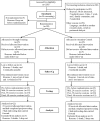Effect of intra-dialytic, low-intensity strength training on functional capacity in adult haemodialysis patients: a randomized pilot trial
- PMID: 20100734
- PMCID: PMC2902890
- DOI: 10.1093/ndt/gfp739
Effect of intra-dialytic, low-intensity strength training on functional capacity in adult haemodialysis patients: a randomized pilot trial
Abstract
Background: Kidney failure is associated with muscle wasting and physical impairment. Moderate- to high-intensity strength training improves physical performance, nutritional status and quality of life in people with chronic kidney disease and in dialysis patients. However, the effect of low-intensity strength training has not been well documented, thus representing the objective of this pilot study.
Methods: Fifty participants (mean +/- SD, age 69 +/- 13 years) receiving long-term haemodialysis (3.7 +/- 4.2 years) were randomized to intra-dialytic low-intensity strength training or stretching (attention-control) exercises twice weekly for a total of 48 exercise sessions. The primary study outcome was physical performance assessed by the Short Physical Performance Battery score (SPPB) after 36 sessions, if available, or carried forward from 24 sessions. Secondary outcomes included lower body strength, body composition and quality of life. Measurements were obtained at baseline and at completion of 24 (mid), 36 (post) and 48 (final) exercise sessions.
Results: Baseline median (IQR) SPPB score was 6.0 (5.0), with 57% of the participants having SPPB scores below 7. Exercise adherence was 89 +/- 15%. The primary outcome could be computed in 44 participants. SPPB improved in the strength training group compared to the attention-control group [21.1% (43.1%) vs. 0.2% (38.4%), respectively, P = 0.03]. Similarly, strength training participants exhibited significant improvements from baseline compared to the control group in knee extensor strength, leisure-time physical activity and self-reported physical function and activities of daily living (ADL) disability; all P < 0.02. Adverse events were common but not related to study participation.
Conclusions: Intra-dialytic, low-intensity progressive strength training was safe and effective among maintenance dialysis patients. Further studies are needed to establish the generalizability of this strength training program in dialysis patients.
Figures


Similar articles
-
The association between six month intra-dialytic resistance training and muscle strength or physical performance in patients with maintenance hemodialysis: a multicenter retrospective observational study.BMC Nephrol. 2019 May 16;20(1):172. doi: 10.1186/s12882-019-1375-1. BMC Nephrol. 2019. PMID: 31096932 Free PMC article.
-
Feasibility and effects of intra-dialytic low-frequency electrical muscle stimulation and cycle training: A pilot randomized controlled trial.PLoS One. 2018 Jul 11;13(7):e0200354. doi: 10.1371/journal.pone.0200354. eCollection 2018. PLoS One. 2018. PMID: 29995947 Free PMC article. Clinical Trial.
-
Erratum.Mult Scler. 2016 Oct;22(12):NP9-NP11. doi: 10.1177/1352458515585718. Epub 2015 Jun 3. Mult Scler. 2016. PMID: 26041800
-
Exercise interventions for improving objective physical function in patients with end-stage kidney disease on dialysis: a systematic review and meta-analysis.Am J Physiol Renal Physiol. 2019 May 1;316(5):F856-F872. doi: 10.1152/ajprenal.00317.2018. Epub 2019 Feb 13. Am J Physiol Renal Physiol. 2019. PMID: 30759022
-
Effects of Exercise on Muscle Fitness in Dialysis Patients: A Systematic Review and Meta-Analysis.Am J Nephrol. 2019;50(4):291-302. doi: 10.1159/000502635. Epub 2019 Sep 3. Am J Nephrol. 2019. PMID: 31480056
Cited by
-
Protocolized exercise improves frailty parameters and lower extremity impairment: A promising prehabilitation strategy for kidney transplant candidates.Clin Transplant. 2020 Sep;34(9):e14017. doi: 10.1111/ctr.14017. Epub 2020 Jul 24. Clin Transplant. 2020. PMID: 32573816 Free PMC article.
-
Exercise intolerance in kidney diseases: physiological contributors and therapeutic strategies.Am J Physiol Renal Physiol. 2021 Feb 1;320(2):F161-F173. doi: 10.1152/ajprenal.00437.2020. Epub 2020 Dec 7. Am J Physiol Renal Physiol. 2021. PMID: 33283641 Free PMC article. Review.
-
Physical activity increases the resistin concentration in hemodialyzed patients without metabolic syndrome.Diabetes Metab Syndr Obes. 2018 Dec 18;12:43-57. doi: 10.2147/DMSO.S186674. eCollection 2019. Diabetes Metab Syndr Obes. 2018. PMID: 30588054 Free PMC article.
-
Effects of progressive resistance exercises on quality of life and functional capacity in pediatric patients with chronic kidney disease: a randomized trail.J Musculoskelet Neuronal Interact. 2019 Jun 1;19(2):187-195. J Musculoskelet Neuronal Interact. 2019. PMID: 31186389 Free PMC article. Clinical Trial.
-
Physical Activity Dose for Hemodialysis Patients: Where to Begin? Results from a Prospective Cohort Study.J Ren Nutr. 2018 Jan;28(1):45-53. doi: 10.1053/j.jrn.2017.07.004. Epub 2017 Sep 8. J Ren Nutr. 2018. PMID: 28893466 Free PMC article.
References
-
- US Renal Data System . National Institutes of Health, National Institute of Diabetes and Digestive and Kidney Diseases. Bethesda, MD; 2002. Annual data report: atlas on end-stage renal disease in the United States.
-
- Nagi SZ. An epidemiology of disability among adults in the United States. Milbank Mem Fund Q Health Soc. 1976;54:439–467. - PubMed
-
- Fried LP, Ferrucci L, Darer J, et al. Untangling the concepts of disability, frailty, and comorbidity: implications for improved targeting and care. J Gerontol A Biol Sci Med Sci. 2004;59:255–263. - PubMed
Publication types
MeSH terms
Grants and funding
LinkOut - more resources
Full Text Sources
Medical

